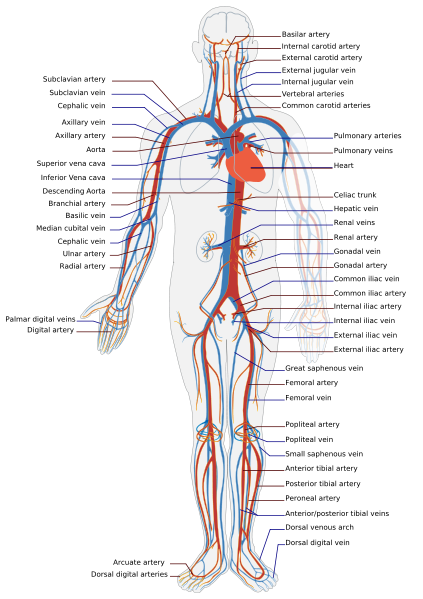Circulatory system
The circulatory system is an organ system that passes nutrients (such as amino acids, electrolytes, and lymph), gases, hormones, blood cells, etc. to and from cells in the body to help fight diseases and help stabilize body temperature and pH to maintain homeostasis.
This system may be seen strictly as a blood distribution network, but some consider the circulatory system as composed of the cardiovascular system, which distributes blood, and the lymphatic system, which distributes lymph. While humans, as well as other vertebrates, have a closed cardiovascular system (meaning that the blood never leaves the network of arteries, veins, and capillaries), some invertebrate groups have an open cardiovascular system. The most primitive animal phyla lack circulatory systems. The lymphatic system, on the other hand, is an open system.
Two types of fluids move through the circulatory system: blood and lymph. The blood, heart, and blood vessels form the cardiovascular system. The lymph, lymph nodes, and lymph vessels form the lymphatic system. The cardiovascular system and the lymphatic system collectively make up the circulatory system.
Human cardiovascular system
The main components of the human cardiovascular system are the heart, the veins, and the blood vessels. It includes the pulmonary circulation, a "loop" through the lungs where blood is oxygenated; and the systemic circulation, a "loop" through the rest of the body to provide oxygenated blood. An average adult contains five to six quarts (roughly 4.7 to 5.7 liters) of blood, which consists of plasma, red blood cells, white blood cells, and platelets. Also, the digestive system works with the circulatory system to provide the nutrients the system needs to keep the heart pumping.
Pulmonary circulation
Pulmonary circulation is the portion of the cardiovascular system which transports oxygen-depleted blood away from the heart, to the lungs, and returns oxygenated blood back to the heart.
Oxygen-deprived blood from the vena cava enters the right atrium of the heart and flows through the tricuspid valve into the right ventricle, from which it is pumped through the pulmonary semilunar valve into the pulmonary arteries which go to the lungs. Pulmonary veins return the now oxygen-rich blood to the heart, where it enters the left atrium before flowing through the mitral valve into the left ventricle. Then, oxygen-rich blood from the left ventricle is pumped out via the aorta, and onto the rest of the body.
Systemic circulation
Systemic circulation is the portion of the cardiovascular system which transports oxygenated blood away from the heart, to the rest of the body, and returns oxygen-depleted blood back to the heart. Systemic circulation is, distance-wise, much longer than pulmonary circulation, transporting blood to every part of the body.
Coronary circulation
The coronary circulatory system provides a blood supply to the heart. As it provides oxygenated blood to the heart, it is by definition a part of the systemic circulatory system.
Heart
The heart pumps oxygenated blood to the body and deoxygenated blood to the lungs. In the human heart, there is one atrium and one ventricle for each circulation, and with both a systemic and a pulmonary circulation there are four chambers in total: left atrium, left ventricle, right atrium, and right ventricle. The right atrium is the upper chamber of the right side of the heart. The blood that is returned to the right atrium is deoxygenated (poor in oxygen) and passed into the right ventricle to be pumped through the pulmonary artery to the lungs for re-oxygenation and removal of carbon dioxide. The left atrium receives newly oxygenated blood from the lungs as well as the pulmonary vein which is passed into the strong left ventricle to be pumped through the aorta to the different organs of the body.
Closed cardiovascular system
The cardiovascular systems of humans are closed, meaning that the blood never leaves the network of blood vessels. In contrast, oxygen and nutrients diffuse across the blood vessel layers and enter interstitial fluid, which carries oxygen and nutrients to the target cells, and carbon dioxide and wastes in the opposite direction. The other component of the circulatory system, the lymphatic system, is not closed. The heart is located in the center of the body between the two lungs. The reason that the heartbeat is felt on the left side is because the left ventricle is pumping harder.
Measurement techniques
- Electrocardiogram - for cardiac electrophysiology
- Sphygmomanometer and stethoscope - for blood pressure
- Pulse meter - for cardiac function (heart rate, rhythm, dropped beats)
- Pulse - commonly used to determine the heart rate in absence of certain cardiac pathologies
- Heart rate variability - used to measure variations of time intervals between heartbeats
- Nail bed blanching test - test for perfusion
- Vessel cannula or catheter pressure measurement - pulmonary wedge pressure or in older animal experiments.
Oxygen transportation
About 98.5% of the oxygen in a sample of arterial blood in a healthy human breathing air at sea-level pressure is chemically combined with hemoglobin molecules. About 1.5% is physically dissolved in the other blood liquids and not connected to hemoglobin. The hemoglobin molecule is the primary transporter of oxygen in mammals and many other species.
See also [ Safety:Bondage#Circulation ]
Chat rooms • What links here • Copyright info • Contact information • Category:Root
